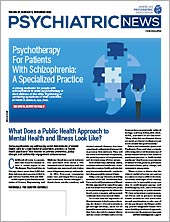More than half of all individuals who were diagnosed with bipolar disorder or schizophrenia by age 28 in a large Finnish population cohort had attended specialist child and adolescent psychiatry services at some stage before their 18th birthday, according to a report in World Psychiatry in September. Moreover, nearly a quarter had been hospitalized for psychiatric illness between the ages of 13 and 17.
Senior author Ian Kelleher, M.D., Ph.D., chair of child and adolescent psychiatry at the University of Edinburgh, said the findings highlight an enormous, untapped potential to predict psychosis and bipolar disorder in youth within already existing pediatric mental health services. He said the findings represent an important additional strategy for identifying young people at risk for schizophrenia in a field that has largely relied on the Clinical High Risk criteria.
In the 1990s, collaboration between researchers and clinicians led to a consensus around a set of Clinical High Risk (CHR) or Ultra High Risk (UHR) criteria, which involves structured assessments of individuals with frank but brief psychotic symptoms (
Predicting Psychosis: Field Moves From Assessment of Clinical Risk to Search for Biomarkers). In 2004, the National Institute of Mental Health funded the North American Prodrome Longitudinal Study (NAPLS), a consortium of nine programs in the United States and Canada that recruited individuals in the community who met criteria for CHR and followed them over time.
Research has shown some 30% of individuals who meet CHR criteria do go on to have a psychotic episode, but others experience a range of other outcomes, and a small subset even appear to recover. Moreover, recent research has suggested that, even at leading clinical centers, only a very small proportion of psychosis cases are captured using the CHR approach.
In an interview with Psychiatric News, Kelleher emphasized that looking at systems of care where young people show up for treatment would appear to be a way to complement the CHR approach to early identification.
“We know the current CHR approach identifies only a relatively small percentage of young people who will go on to develop psychosis or bipolar disorder,” he said. “So we need to come up with additional strategies to increase the numbers of people we can identify who are at high risk. The idea is that instead of just looking at symptoms, we think about what systems of care capture young people at risk for serious mental illness and apply an epidemiological approach to that population.”
Kelleher and colleagues used data from the nationwide 1987 Finnish Birth Cohort study, which includes all 59,476 Finns born in the year 1987 as documented in official register data recorded from birth until December 31, 2015. Information on exposures (having contact with specialty child mental health services) and outcomes (psychotic and bipolar disorder diagnoses) were derived from the Care Register for Health Care. This register covers all inpatient visits during the cohort members’ lifetime, and all outpatient visits to secondary level health care from the year 1998 onward. For each visit, the register records diagnoses assigned, medical specialty of treatment provided, and information on whether the visit was inpatient or outpatient.
The primary outcome was diagnosis of bipolar disorder or schizophrenia by age 28.
Within the overall sample, 1,785 individuals (3.2%) had a lifetime diagnosis of any psychosis or bipolar disorder. Of individuals with at least one inpatient psychiatric admission, 24.0% were diagnosed with psychosis or bipolar disorder by age 28 years, versus 2.3% of those without an inpatient psychiatric admission. The percentage of individuals diagnosed with a psychotic or bipolar disorder by age 28 years was 11.5% among those with a first inpatient psychiatric admission before age 13 years and 36.5% among those with a first inpatient psychiatric admission from age 13 to 17 years.
Public psychiatric treatment is provided to children up to age 18 through Child and Adolescent Mental Health Services (CAMHS) across Finland and other European countries, as well as in many other parts of the world. Kelleher acknowledged that the absence of an equivalent to CAMHS in the United States—as well as more generally the vast differences in access to care and the way children access psychiatric care in the United States—makes generalization to an American setting difficult. But he said the important point is that youth who do access psychiatric care, especially inpatient care, are liable to be at risk; and that looking at systems where adolescents seek care may be more productive in terms of finding at-risk youth than only assessing for symptoms.
“Our findings show that a very high proportion of individuals who develop psychosis had accessed pediatric psychiatry services at some stage in childhood. Young people who have had inpatient psychiatric admissions in adolescence, in particular, were a very high-risk group when followed over time.”
He said a challenge with the CHR criteria is that most individuals are identified in early adulthood, much closer to the time of acute psychosis. “Identifying individuals who are at risk in adolescence, on the other hand, is an opportunity to intervene during a crucial stage of social and biological development, at a time of greater brain plasticity than in adulthood, when key neurodevelopmental processes are taking place, including extensive synaptic pruning and maturation of the prefrontal cortex.” (Synaptic pruning is the natural process whereby the brain eliminates unnecessary connections between brain cells during adolescence; individuals who develop psychosis are believed to undergo excess pruning.)
Kelleher said a next step is to look at what factors and variables among the children and adolescents who present to child psychiatry services—family history, socioeconomic status, specific diagnoses, as well as psychological and biological measures—may especially identify youth at the greatest risk of later psychosis or bipolar disorder.
“Something important for clinicians and researchers to reflect on is that we think of psychosis as something that typically presents to psychiatry services in early adulthood,” Kelleher said. “Our findings show that these individuals are already coming to our child psychiatry services—and they’re coming in really large numbers. Although they might not yet have psychosis when they first present to child psychiatry services, they do have this neurodevelopmental risk. And at this earlier stage of social and biological development, I think this risk might be much more amenable to intervention.”
He added, “That’s really exciting for the future of psychosis prediction and prevention research.” ■

